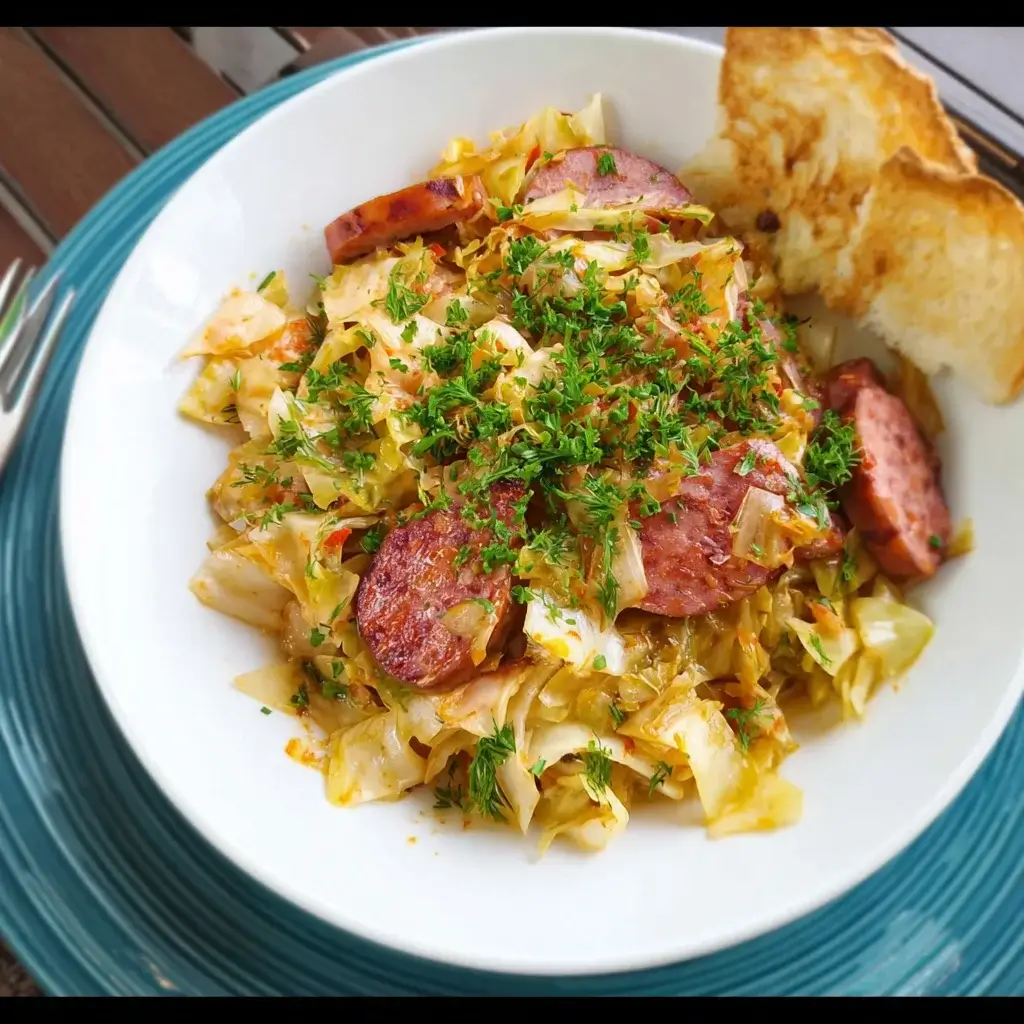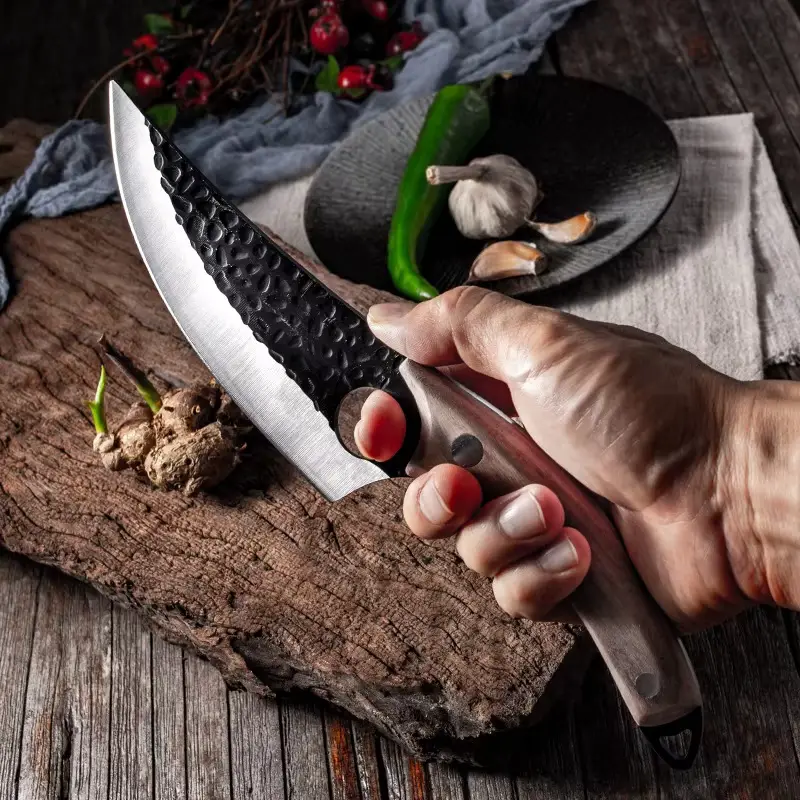Of all the dishes that connect me to my heritage, none is as humble yet profoundly satisfying as Łazanki. I wasn’t fortunate enough to grow up with a Polish Babcia spooning this from a pot, but I discovered it in a small, family-run Polish deli in a neighborhood I once lived in. On a cold, gray afternoon, I asked the woman behind the counter what her favorite comfort food was, and without hesitation, she pointed to a steaming tray of what looked like fried cabbage, noodles, and sausage. She called it Łazanki. I took a container home, skeptical but intrigued. The moment I opened it, the aroma of sweet, caramelized onions, savory smoked sausage, and earthy cabbage filled my small kitchen. It wasn’t fancy. It wasn’t complex. But with the first bite, I understood. It was the taste of home, even if it wasn’t my own. It was warm, hearty, and deeply comforting. I spent the next month perfecting my own version, and it has since become a fixture in our family’s meal rotation, especially when the weather turns cool. It’s the meal my family requests after a long week, the one that fills the house with an incredible aroma and brings everyone to the table, ready for a bowl of pure, unpretentious comfort.
The Heart of Polish Comfort Food: Unveiling Łazanki
Welcome to a journey into the heart of authentic Polish home cooking. Łazanki (pronounced wah-ZAHN-kee) is a classic Polish pasta dish that embodies the soul of Eastern European cuisine: simple, hearty, and made with love. At its core, it’s a delightful combination of pasta, sautéed cabbage, and smoky kielbasa sausage. While ingredients may vary slightly from family to family, the essence remains the same—a one-pot wonder that transforms humble ingredients into a meal bursting with savory, sweet, and smoky flavors.
The name “łazanki” refers to the small, square or rhomboid-shaped noodles traditionally used in the dish. The name itself is believed to have been borrowed from the Italian “lasagna,” a nod to the historical influence of Italian cuisine on the Polish court in the 16th century. However, the dish itself is uniquely Polish, a perfect marriage of rustic cabbage and onion with the rich, satisfying flavor of smoked sausage. This recipe is more than just a set of instructions; it’s an invitation to create a dish that has warmed Polish families for generations.
Why This Łazanki Recipe is Authentically Delicious
In a world of complex and trendy recipes, Łazanki stands out for its beautiful simplicity. This specific recipe is designed to maximize flavor at every step, ensuring your final dish is rich, balanced, and utterly irresistible.
- Deep Caramelization: The secret to truly exceptional Łazanki is patience. We don’t just cook the cabbage; we slowly sauté it with onions until it becomes sweet, tender, and beautifully caramelized. This process coaxes out a depth of flavor that is the heart and soul of the dish.
- The Power of Kielbasa: We use authentic Polish kielbasa, a smoked sausage that releases its savory, garlic-infused fat as it cooks. This fat becomes the flavor base for sautéing the vegetables, ensuring every single component is infused with its smoky goodness.
- A Perfect Balance of Textures: The dish is a symphony of textures. You have the soft, yielding pasta, the tender-crisp cabbage, the savory chew of the kielbasa, and often, the crispy bits of rendered bacon or onion.
- One-Pot Wonder: While you cook the pasta separately, the main components of the dish all come together in a single large skillet or Dutch oven. This not only makes for easier cleanup but also allows the flavors to meld together beautifully as they cook.
- Rooted in Tradition: This recipe stays true to the traditional methods while providing clear, easy-to-follow steps for the modern home cook. It captures the authentic taste that makes this dish a beloved staple in Polish households.
Complete Recipe Ingredients
Gathering your ingredients is the first step to creating this hearty meal. For the most authentic flavor, seek out genuine Polish kielbasa at a European deli or a well-stocked supermarket.
- For the Pasta:
- Pasta: 12 oz (340g) Łazanki pasta squares. If unavailable, medium egg noodles or farfalle (bow-tie pasta) are excellent substitutes.
- For the Cabbage and Aromatics:
- Green Cabbage: 1 medium head (about 2-2.5 lbs / 1 kg), cored and roughly chopped or sliced
- Yellow Onion: 1 large, chopped
- Garlic: 3 cloves, minced
- For the Sausage and Fat:
- Polish Kielbasa: 1 lb (450g), sliced into ¼-inch thick rounds
- Bacon: 4 strips, chopped (optional, but highly recommended for flavor)
- Unsalted Butter or Vegetable Oil: 2 tablespoons (use if not using bacon)
- Seasoning and Finishing Touches:
- Salt: 1 teaspoon, plus more for the pasta water
- Black Pepper: 1 teaspoon, freshly ground
- Caraway Seeds: 1 teaspoon (optional, but traditionally paired with cabbage)
- Reserved Pasta Water: ½ cup
- Fresh Dill or Parsley: ¼ cup, chopped, for garnish
- Sour Cream: For serving (optional, but classic)
A Closer Look at the Key Ingredients
- The Pasta: Traditional łazanki are simple flour-and-egg pasta squares. Finding them can be tricky outside of Polish markets. Farfalle (bow-tie pasta) is the perfect substitute in both shape and texture. Medium or wide egg noodles also work beautifully, adding a lovely richness to the dish.
- The Kielbasa: Not all sausage is created equal. For this dish, you must use a pre-cooked, smoked Polish sausage known as Polska Kielbasa. Its distinctive smoky, garlicky flavor is essential to the dish’s profile. Do not use fresh, uncooked sausage like Italian sausage or bratwurst.
- The Cabbage: A simple head of green cabbage is all you need. The key is how you cook it. A slow sauté breaks down its tough fibers and transforms its flavor from cruciferous and slightly bitter to mellow, sweet, and tender.
- The Fat: Starting the dish by rendering bacon provides not only crispy, savory bits but also a flavorful fat to cook the rest of the ingredients in. If you omit the bacon, a combination of butter and oil will provide the necessary richness and prevent burning.
Step-by-Step Cooking Instructions
Follow these steps carefully to build layers of flavor, resulting in a perfectly balanced and delicious Łazanki.
Step 1: Cook the Pasta
Bring a large pot of heavily salted water to a rolling boil. Add your chosen pasta (Łazanki squares, farfalle, or egg noodles) and cook according to the package directions until it is al dente. Just before you drain the pasta, reserve about 1 cup of the starchy pasta water. Drain the pasta well and set it aside.
Step 2: Render Fat and Brown the Kielbasa
In a large, heavy-bottomed skillet, Dutch oven, or braiser, cook the chopped bacon (if using) over medium heat. Stir occasionally until the bacon is crispy and has rendered most of its fat, about 6-8 minutes. Using a slotted spoon, remove the crispy bacon bits to a paper towel-lined plate, leaving the rendered fat in the skillet. If not using bacon, simply heat the butter and/or oil in the skillet.
Add the sliced kielbasa to the hot fat in a single layer (you may need to do this in two batches). Cook for 3-4 minutes per side, until the kielbasa is nicely browned and slightly crisped at the edges. Remove the browned kielbasa from the skillet and set it aside with the bacon.
Step 3: Sauté the Aromatics
You should have a good amount of flavorful fat left in the skillet. Add the chopped large onion to the skillet. Sauté over medium heat, stirring frequently, for about 7-10 minutes. The onion should be soft, translucent, and just beginning to turn a light golden brown. Scrape up any browned bits from the bottom of the pan as the onions release their moisture. Add the minced garlic and the optional caraway seeds and cook for one more minute until fragrant.
Step 4: Cook the Cabbage
Add the chopped cabbage to the skillet. It will likely look like a huge, overflowing amount, but don’t worry—it will cook down significantly. Add 1 teaspoon of salt and ½ teaspoon of black pepper. Stir everything together as best you can. Cover the skillet and let the cabbage cook for about 10 minutes, stirring once or twice. This initial steaming will help it wilt down.
Step 5: Caramelize the Cabbage
After the cabbage has wilted, remove the lid. Reduce the heat to medium-low. Continue to cook the cabbage, stirring every 5-7 minutes, for another 20-30 minutes. This is the most important step for developing flavor. Be patient. The cabbage is done when it is very tender, sweet, and has developed deep golden-brown caramelized spots. Do not rush this process!
Step 6: Combine and Finish the Dish
Return the cooked kielbasa and the crispy bacon bits to the skillet with the cabbage. Add the cooked pasta to the skillet as well. Stir everything together gently until well combined.
Pour in about ½ cup of the reserved pasta water. This will create a light, glossy sauce that helps bring everything together and prevents the dish from being dry. Stir until the pasta water has been mostly absorbed and everything is heated through.
Step 7: Season and Serve
Taste the Łazanki and adjust the seasoning with more salt and freshly ground black pepper as needed. Kielbasa and bacon are already salty, so it’s important to taste before adding too much more salt. Stir in the chopped fresh dill or parsley. Serve immediately in warm bowls, with a dollop of sour cream on top if desired.
Nutrition Facts
These nutritional values are an approximation and can vary based on the specific type of kielbasa, whether bacon is used, and the serving size.
- Servings: 6-8 hearty servings
- Calories per serving: Approximately 550-650 kcal
Preparation Time
While the cooking time is significant due to the cabbage caramelization, the active prep time is minimal.
- Prep Time: 15 minutes
- Cook Time: 50-60 minutes
- Total Time: Approximately 1 hour and 15 minutes
How to Serve This Hearty Polish Dish
Łazanki is a rustic, humble dish, and it is best served in a way that honors its comforting nature.
- The Classic Way:
- Serve it hot and fresh, piled high in large, shallow bowls.
- A generous dollop of full-fat sour cream on top is a classic and highly recommended accompaniment. The cool, tangy cream cuts through the richness of the sausage and cabbage beautifully.
- A final sprinkle of freshly chopped dill is the most traditional garnish, adding a bright, herbaceous note that perfectly complements the flavors. Fresh parsley also works well.
- Simple Side Dishes:
- Rye Bread: A slice of hearty rye bread with butter is perfect for sopping up any flavors left in the bowl.
- Cucumber Salad (Mizeria): A simple Polish cucumber salad made with thinly sliced cucumbers, sour cream, and dill is a wonderfully refreshing and light side dish.
- Pickled Beets: The earthy sweetness and acidity of pickled beets provide a fantastic contrast to the savory Łazanki.
- Beverage Pairings:
- Polish Beer: A crisp, cold Polish lager like Żywiec or Tyskie is the perfect beverage to wash down this hearty meal.
- Vodka: For a truly traditional experience, serve small, chilled glasses of Polish vodka to sip alongside the meal.
Additional Tips for Perfect Łazanki
Master this beloved dish with these five essential tips from a seasoned kitchen.
- Don’t Rush the Cabbage: I cannot emphasize this enough. The difference between good Łazanki and great Łazanki is the cabbage. Rushing it on high heat will steam or burn it. Cooking it low and slow allows its natural sugars to release and caramelize, creating a deep, sweet flavor that is irreplaceable.
- Embrace the Tang with Sauerkraut: For a delicious variation, substitute half of the fresh cabbage with one pound of sauerkraut. Be sure to rinse and thoroughly squeeze the sauerkraut dry before adding it to the pan. This adds a wonderful tangy flavor that cuts through the richness of the dish. Add it during the last 15 minutes of the cabbage cooking time.
- Use Caraway Seeds: While listed as optional, caraway seeds are a classic Eastern European pairing with cabbage for a reason. Their unique, slightly anise-like flavor is the perfect aromatic counterpoint to the sweet cabbage and smoky sausage. If you want a truly authentic taste, don’t skip them.
- Don’t Forget the Pasta Water: That starchy water is liquid gold. It helps to bind the “sauce” (the rendered fats and cabbage juices) to the noodles, ensuring every bite is flavorful and preventing the dish from feeling dry or oily. It’s a simple step that makes a huge difference.
- Better the Next Day: Łazanki is one of those magical dishes that often tastes even better the next day. The flavors have more time to meld and deepen. It reheats beautifully in a skillet over medium-low heat. You may need to add a splash of water to loosen it up as it reheats.
Frequently Asked Questions (FAQ)
Here are some common questions you might have about making Łazanki.
1. What kind of pasta can I use if I can’t find łazanki noodles?
Finding authentic łazanki pasta squares can be difficult. The best and most widely available substitute is farfalle (bow-tie pasta), as its shape is similar and it holds up well. Medium or wide egg noodles are another excellent choice and are what many Polish-American families use. In a pinch, any short pasta like penne or rotini will work.
2. Can I use a different type of sausage?
For the most authentic flavor, smoked Polish kielbasa is a must. However, if you cannot find it, you can substitute another type of pre-cooked smoked sausage, such as a good quality smoked German bratwurst or even Andouille sausage for a Cajun twist (though this will significantly change the flavor profile). Avoid using fresh, uncooked sausage.
3. Can I add other vegetables to this dish?
Yes! The most common addition is mushrooms. Sliced cremini or button mushrooms can be sautéed along with the onions to add another layer of earthy flavor. Some variations also include sliced bell peppers or shredded carrots, added with the cabbage.
4. How can I make a vegetarian version of Łazanki?
To make a delicious vegetarian Łazanki, omit the bacon and kielbasa. Use a generous amount of butter and oil for cooking. To replicate the savory, umami flavor, add 1 pound of sliced mushrooms and sauté them until deeply browned. A dash of smoked paprika can also help mimic the smoky flavor lost from the kielbasa.
5. How should I store and reheat leftovers?
Łazanki makes for fantastic leftovers. Store it in an airtight container in the refrigerator for up to 4 days. To reheat, you can use the microwave, but the best method is in a skillet over medium-low heat. Add a tablespoon or two of water to the pan to help steam the noodles and prevent them from drying out. Stir occasionally until heated through.

Lazanki With Kielbasa Polish Cabbage Pasta recipe
Ingredients
-
For the Pasta:
-
Pasta: 12 oz (340g) Łazanki pasta squares. If unavailable, medium egg noodles or farfalle (bow-tie pasta) are excellent substitutes.
-
-
For the Cabbage and Aromatics:
-
Green Cabbage: 1 medium head (about 2-2.5 lbs / 1 kg), cored and roughly chopped or sliced
-
Yellow Onion: 1 large, chopped
-
Garlic: 3 cloves, minced
-
-
For the Sausage and Fat:
-
Polish Kielbasa: 1 lb (450g), sliced into ¼-inch thick rounds
-
Bacon: 4 strips, chopped (optional, but highly recommended for flavor)
-
Unsalted Butter or Vegetable Oil: 2 tablespoons (use if not using bacon)
-
-
Seasoning and Finishing Touches:
-
Salt: 1 teaspoon, plus more for the pasta water
-
Black Pepper: 1 teaspoon, freshly ground
-
Caraway Seeds: 1 teaspoon (optional, but traditionally paired with cabbage)
-
Reserved Pasta Water: ½ cup
-
Fresh Dill or Parsley: ¼ cup, chopped, for garnish
-
Sour Cream: For serving (optional, but classic)
-
Instructions
Step 1: Cook the Pasta
Bring a large pot of heavily salted water to a rolling boil. Add your chosen pasta (Łazanki squares, farfalle, or egg noodles) and cook according to the package directions until it is al dente. Just before you drain the pasta, reserve about 1 cup of the starchy pasta water. Drain the pasta well and set it aside.
Step 2: Render Fat and Brown the Kielbasa
In a large, heavy-bottomed skillet, Dutch oven, or braiser, cook the chopped bacon (if using) over medium heat. Stir occasionally until the bacon is crispy and has rendered most of its fat, about 6-8 minutes. Using a slotted spoon, remove the crispy bacon bits to a paper towel-lined plate, leaving the rendered fat in the skillet. If not using bacon, simply heat the butter and/or oil in the skillet.
Add the sliced kielbasa to the hot fat in a single layer (you may need to do this in two batches). Cook for 3-4 minutes per side, until the kielbasa is nicely browned and slightly crisped at the edges. Remove the browned kielbasa from the skillet and set it aside with the bacon.
Step 3: Sauté the Aromatics
You should have a good amount of flavorful fat left in the skillet. Add the chopped large onion to the skillet. Sauté over medium heat, stirring frequently, for about 7-10 minutes. The onion should be soft, translucent, and just beginning to turn a light golden brown. Scrape up any browned bits from the bottom of the pan as the onions release their moisture. Add the minced garlic and the optional caraway seeds and cook for one more minute until fragrant.
Step 4: Cook the Cabbage
Add the chopped cabbage to the skillet. It will likely look like a huge, overflowing amount, but don’t worry—it will cook down significantly. Add 1 teaspoon of salt and ½ teaspoon of black pepper. Stir everything together as best you can. Cover the skillet and let the cabbage cook for about 10 minutes, stirring once or twice. This initial steaming will help it wilt down.
Step 5: Caramelize the Cabbage
After the cabbage has wilted, remove the lid. Reduce the heat to medium-low. Continue to cook the cabbage, stirring every 5-7 minutes, for another 20-30 minutes. This is the most important step for developing flavor. Be patient. The cabbage is done when it is very tender, sweet, and has developed deep golden-brown caramelized spots. Do not rush this process!
Step 6: Combine and Finish the Dish
Return the cooked kielbasa and the crispy bacon bits to the skillet with the cabbage. Add the cooked pasta to the skillet as well. Stir everything together gently until well combined.
Pour in about ½ cup of the reserved pasta water. This will create a light, glossy sauce that helps bring everything together and prevents the dish from being dry. Stir until the pasta water has been mostly absorbed and everything is heated through.
Step 7: Season and Serve
Taste the Łazanki and adjust the seasoning with more salt and freshly ground black pepper as needed. Kielbasa and bacon are already salty, so it’s important to taste before adding too much more salt. Stir in the chopped fresh dill or parsley. Serve immediately in warm bowls, with a dollop of sour cream on top if desired.
Nutrition
- Serving Size: one normal portion
- Calories: 550-650





